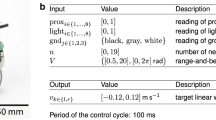Abstract
Novelty search is a recent and promising evolutionary technique. The main idea behind it is to reward novel solutions instead of progress towards a fixed goal, in order to avoid premature convergence and deception. In this paper, we use novelty search together with NEAT, to evolve neuro-controllers for a swarm of simulated robots that should perform an aggregation task. In the past, novelty search has been applied to single robot systems. We demonstrate that novelty search can be applied successfully to multirobot systems, and we discuss the challenges introduced when moving from a single robot setup to a multirobot setup. Our results show that novelty search can outperform the fitness-based evolution in swarm robotic systems, finding (i) a more diverse set of successful solutions to an aggregation task, (ii) solutions with higher fitness scores earlier in the evolutionary runs, and (iii) simpler solutions in terms of the topological complexity of the evolved neural networks.
Access this chapter
Tax calculation will be finalised at checkout
Purchases are for personal use only
Preview
Unable to display preview. Download preview PDF.
Similar content being viewed by others
References
Bahgeçi̇, E., Şahi̇n, E.: Evolving aggregation behaviors for swarm robotic systems: A systematic case study. In: Swarm Intelligence Symposium, pp. 333–340. IEEE, New York (2005)
Baldassarre, G., Nolfi, S., Parisi, D.: Evolving mobile robots able to display collective behaviors. Artificial Life 9(3), 255–268 (2003)
Cuccu, G., Gomez, F.: When Novelty Is Not Enough. In: Di Chio, C., Cagnoni, S., Cotta, C., Ebner, M., Ekárt, A., Esparcia-Alcázar, A.I., Merelo, J.J., Neri, F., Preuss, M., Richter, H., Togelius, J., Yannakakis, G.N. (eds.) EvoApplications 2011, Part I. LNCS, vol. 6624, pp. 234–243. Springer, Heidelberg (2011)
Goldberg, D.E.: Simple genetic algorithms and the minimal, deceptive problem. In: Genetic Algorithms and Simulated Annealing. Research Notes in Artificial Intelligence, pp. 74–88. Pitman Publishing, London (1987)
Harvey, I., Husbands, P., Cliff, D., et al.: Issues in evolutionary robotics. In: Second Int. Conf. on Simulation of Adaptive Behavior, pp. 364–373. MIT Press, Cambridge (1993)
Heaton, J.: Programming Neural Networks with Encog3 in Java. Heaton Research, Chesterfield (2011)
Hugues, L., Bredeche, N.: Simbad: An Autonomous Robot Simulation Package for Education and Research. In: Nolfi, S., Baldassarre, G., Calabretta, R., Hallam, J.C.T., Marocco, D., Meyer, J.-A., Miglino, O., Parisi, D. (eds.) SAB 2006. LNCS (LNAI), vol. 4095, pp. 831–842. Springer, Heidelberg (2006)
Kohonen, T.: The self-organizing map. Proc. of the IEEE 78(9), 1464–1480 (1990)
Lehman, J., Stanley, K.O.: Revising the evolutionary computation abstraction: minimal criteria novelty search. In: Genetic and Evolutionary Computation Conf., pp. 103–110. ACM, New York (2010)
Lehman, J., Stanley, K.O.: Abandoning objectives: Evolution through the search for novelty alone. Evolutionary Computation 19(2), 189–223 (2011)
Lehman, J., Stanley, K.O.: Evolving a diversity of virtual creatures through novelty search and local competition. In: Genetic and Evolutionary Computation Conf., pp. 211–218. ACM, New York (2011)
Mondada, F., Bonani, M., Raemy, X., Pugh, J., Cianci, C., Klaptocz, A., Magnenat, S., Zufferey, J.C., Floreano, D., Martinoli, A.: The e-puck, a robot designed for education in engineering. In: 9th Conf. on Autonomous Robot Systems and Competitions, pp. 59–65. IPCB, Castelo Branco (2009)
Mouret, J.: Novelty-based multiobjectivization. New Horizons in Evolutionary Robotics, pp. 139–154. Springer, Berlin (2011)
Risi, S., Vanderbleek, S.D., Hughes, C.E., Stanley, K.O.: How novelty search escapes the deceptive trap of learning to learn. In: Genetic and Evolutionary Computation Conf., pp. 153–160. ACM, New York (2009)
Soysal, O., Bahgeçi̇, E., Şahi̇n, E.: Aggregation in swarm robotic systems: Evolution and probabilistic control. Turkish Journal of Electrical Eng. 15(2), 199–225 (2007)
Stanley, K.O.: Efficient Evolution of Neural Networks Through Complexification. Ph.D. thesis, Dep. of Computer Sciences, The University of Texas, Austin (2004)
Stanley, K.O., Miikkulainen, R.: Evolving neural network through augmenting topologies. Evolutionary Computation 10(2), 99–127 (2002)
Trianni, V., Groß, R., Labella, T.H., Şahin, E., Dorigo, M.: Evolving Aggregation Behaviors in a Swarm of Robots. In: Banzhaf, W., Ziegler, J., Christaller, T., Dittrich, P., Kim, J.T. (eds.) ECAL 2003. LNCS (LNAI), vol. 2801, pp. 865–874. Springer, Heidelberg (2003)
Whitley, L.D.: Fundamental principles of deception in genetic search. In: Foundations of Genetic Algorithms, pp. 221–241. Morgan Kaufmann, San Mateo (1991)
Author information
Authors and Affiliations
Editor information
Editors and Affiliations
Rights and permissions
Copyright information
© 2012 Springer-Verlag Berlin Heidelberg
About this paper
Cite this paper
Gomes, J., Urbano, P., Christensen, A.L. (2012). Introducing Novelty Search in Evolutionary Swarm Robotics. In: Dorigo, M., et al. Swarm Intelligence. ANTS 2012. Lecture Notes in Computer Science, vol 7461. Springer, Berlin, Heidelberg. https://doi.org/10.1007/978-3-642-32650-9_8
Download citation
DOI: https://doi.org/10.1007/978-3-642-32650-9_8
Publisher Name: Springer, Berlin, Heidelberg
Print ISBN: 978-3-642-32649-3
Online ISBN: 978-3-642-32650-9
eBook Packages: Computer ScienceComputer Science (R0)




